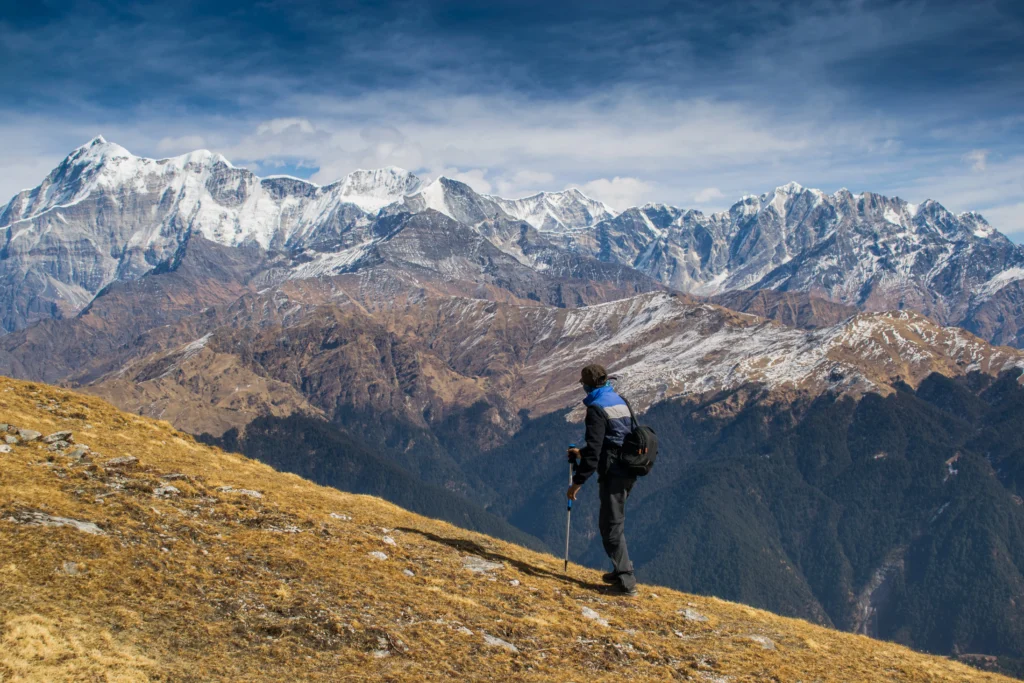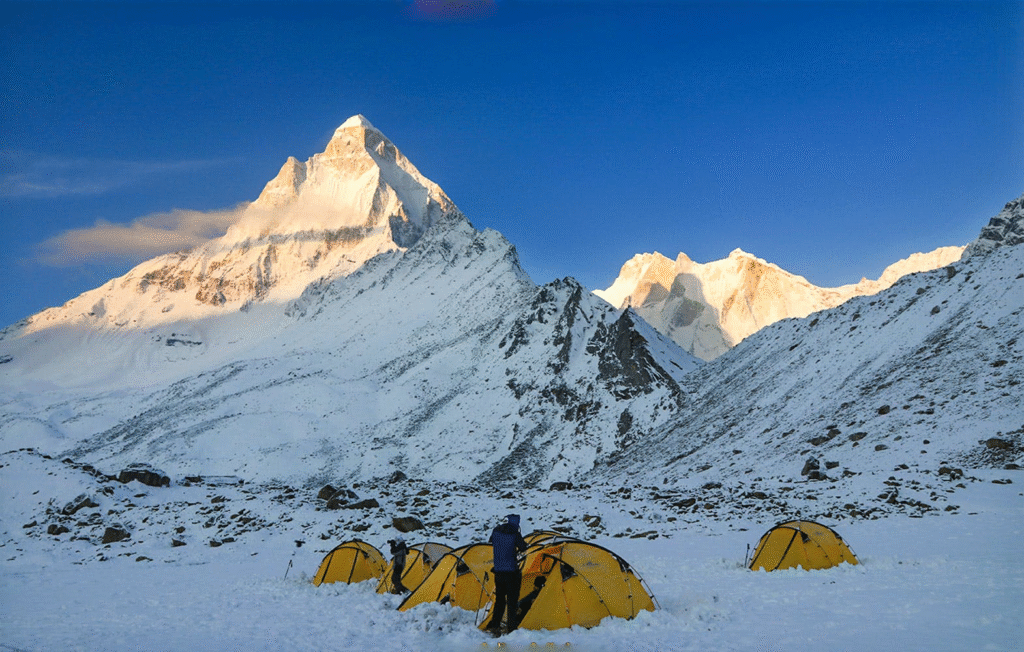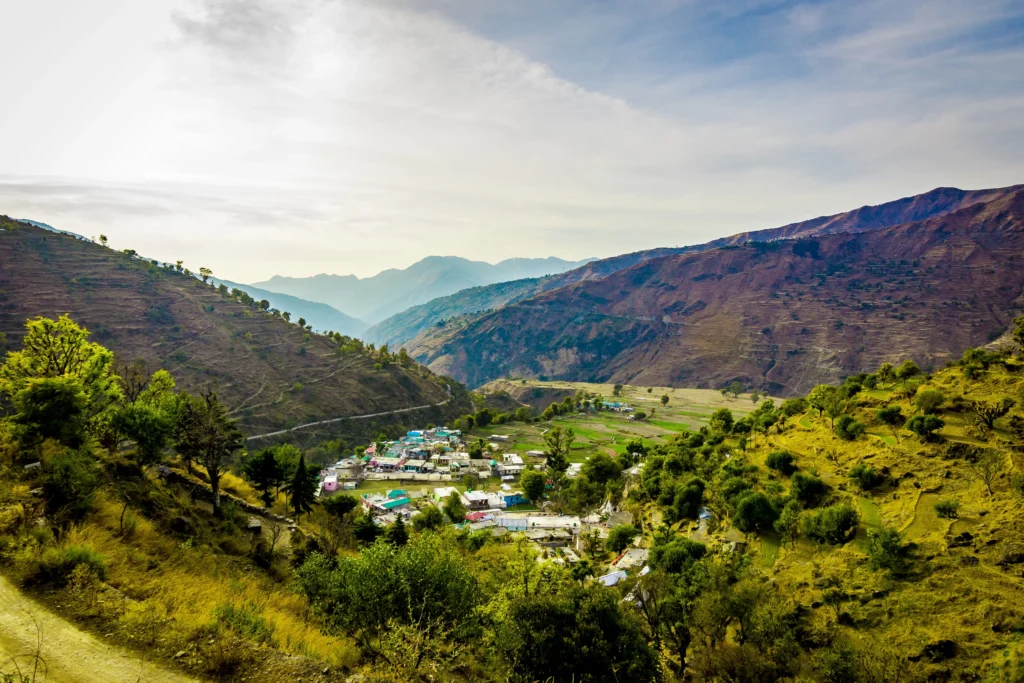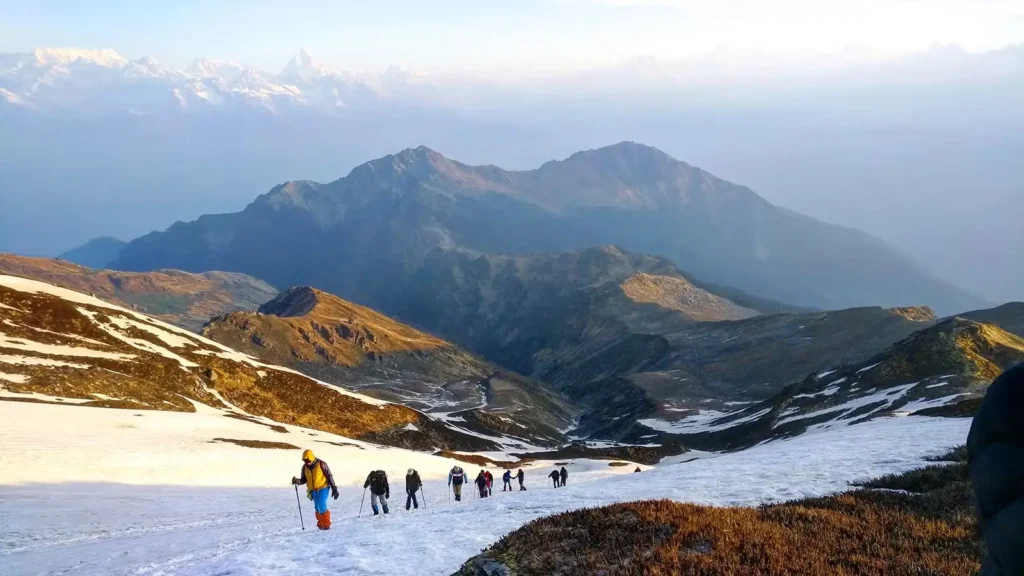
Let’s be honest. When you hear the words “Himalayan Trek,” your brain probably pictures two things: either you’re a seasoned mountaineer in specialized boots, hauling enough gear for a month, or you’re a total novice getting dragged up a snowdrift. The Chopta-Tungnath-Chandrashila Trek is the beautiful, accessible middle ground—the one trek that every single person, from the weekend warrior to the spiritual seeker, should have on their bucket list.
This isn’t just a trail; it’s a living contradiction. It’s challenging enough to feel like a real accomplishment, yet short enough to tackle in a long weekend. It’s a journey to the highest Shiva shrine on Earth, yet it offers some of the most stunning 360-degree mountain views you can find anywhere, full stop.
The whole experience is centred around a charming, undulating grassland known as Chopta, a place so ridiculously picturesque that the locals have affectionately dubbed it the “Mini Switzerland of Uttarakhand.” They’re not wrong. Imagine stepping out of your tent or homestay and seeing a wide-open valley of velvety green or pristine white snow, depending on the season, framed by towering oaks and pines. That view alone pays for the trip.
I’m going to walk you through everything, from the myth that makes this path sacred to the exact moment the sunrise hits the peaks.
Part I: The Road Less Travelled (and the Drive that Makes it Worth it)
Getting There is Half the Adventure
The journey to Chopta usually kicks off from a city like Rishikesh or Dehradun. Let me tell you, this drive is a masterpiece of mountain road engineering. It’s long—figure on a good 8 to 10 hours—but you’ll barely notice the time flying by.
You’ll follow the Alaknanda and Bhagirathi rivers, watching them snake through the valley until they meet at Devprayag, forming the mighty Ganga.
Your base camp will likely be the quaint, tiny village of Sari or the Chopta area itself, often at a beautiful spot like Baniyakund. Sari is a proper Garhwali hamlet, and staying there, even for just a night, gives you a crucial taste of local life before you hit the high trails.
The Detour that Cleanses the Soul: Deoriatal
If you have an extra day—and trust me, you should—you have to start with the trek to Deoriatal. It’s a short, easy 2.5 to 3 km hike from Sari Village, primarily through dense forests that smell earthy and clean.
Deoriatal is a high-altitude lake, and it’s famous for one thing: the mirror reflection of the Chaukhamba massif in its still waters. It’s such an iconic image that photos of it barely do it justice. I recall setting up my tent near the lake, the evening air settling in, and watching the peaks turn from gold to deep blue. It feels like the entire mountain range is posing just for you. This spot is also famous in the local lore as the place where the Pandavas were questioned by the Yaksha, a mythological spirit guardian, before they could drink the lake’s water. It’s a powerful start to the spiritual leg of the journey.
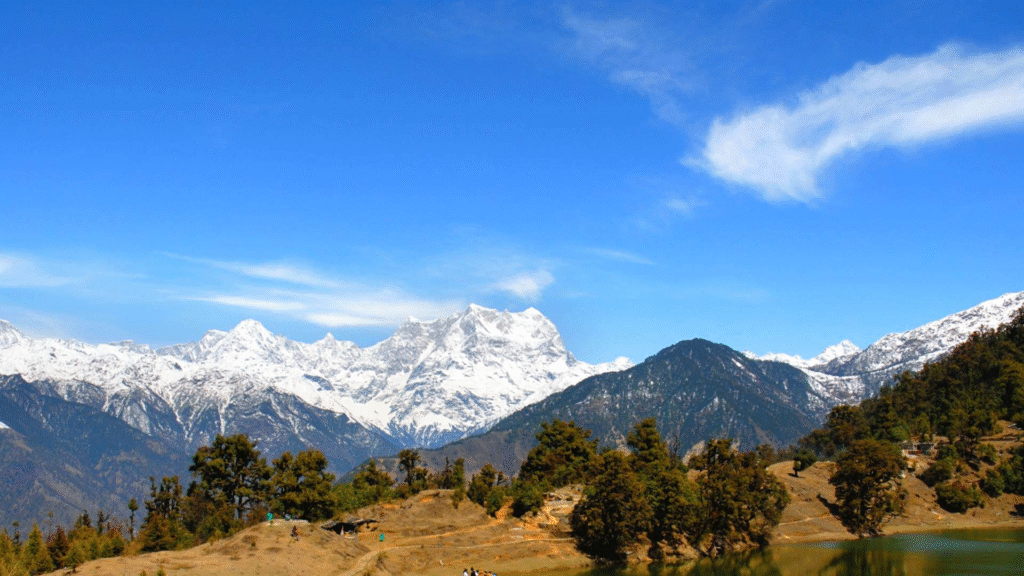
Part II: The Pilgrimage to the Sky
The Chopta Base: Mini Switzerland, Maximum Calm
After Sari, you’ll drive a short way (or, if you’re doing the multi-day circuit, trek) to the starting point near Chopta/Baniyakund, sitting at around 8,790 feet (2,680 m). This is where the magic begins.
The actual trek to Tungnath is only about 3.5 km. It’s a well-defined stone-paved path—not a rugged mountain goat track—which is why it’s so manageable for beginners. But don’t let the short distance fool you; you’re gaining serious altitude, climbing over 3,000 feet in that short stretch. The air gets noticeably thinner, which is a perfect, humbling reminder that you are, indeed, in the mighty Himalayas.
The trail winds through those spectacular bugyals (high-altitude meadows) and dense forests. If you trek in the spring (March-April), you’ll be walking through tunnels of rhododendron—or Buransh—trees ablaze with deep red and vibrant pink flowers. The sheer volume of color is unbelievable; it feels like the forest itself is celebrating your journey.
Tungnath Temple: Touching the Divine
Finally, you crest a ridge and the Tungnath Temple appears. Standing at roughly 12,106 feet (3,690 m), it is officially the highest Shiva temple in the world. Just let that sink in.
The temple itself is a simple, beautiful stone structure, said to be over a thousand years old. It’s part of the Panch Kedar circuit—five holy sites dedicated to Shiva, whose body parts are said to have appeared at these different locations after he disguised himself as a bull (Nandi) to evade the Pandavas. Here at Tungnath, the bahu (arms) are worshipped.
Part III: The Summit and the Celestial View
Chandrashila: The Moon Rock Awaits
After Tungnath, the final push is to the Chandrashila summit . This part is a steeper 1.5 km stretch, taking you up to about 13,123 feet. This is where your lungs and legs will truly get a workout.
Most trekkers tackle this stretch in the very early hours of the morning to catch the sunrise. The climb in the pre-dawn darkness, lit only by your headlamp and the insane canopy of stars overhead, is an experience I can’t fully describe. It’s cold, your breath plumes out like smoke, and you might silently curse the person who convinced you to wake up at 4:00 AM.
But then, you reach the summit.
The 360-Degree Himalayan Panorama
You will instantly forget the struggle. The view from Chandrashila is arguably one of the most rewarding and accessible summit views in the entire Indian Himalayas.
As the sun begins to creep above the horizon, the world unfolds beneath you:
You are surrounded, truly surrounded, by giants.
To the north-west, you’ll see the Bandarpunch massif.
To the east, the sacred and majestic Nanda Devi—the second-highest mountain in India—rises into the sky.
The unmistakable, three-peaked pyramid of Trishul stands tall.
And directly in front of you, the colossal, four-peaked block of the
the colossal, four-peaked block of the Chaukhamba massif dominates the sky, looking absolutely impossible in its scale.
The light hits the peaks one by one—a moment called “The Golden Hour”—turning the snow from cold, pale blue to fiery orange and then brilliant gold. It is a moment of pure, humbling silence. You are standing on top of the world, feeling tiny, powerful, and completely alive all at once. That’s the reward. That’s the Chandrashila magic.
Part IV: The Sanctuary’s Secrets and Local Life
Kedarnath Wildlife Sanctuary: Flora and Fauna
The entire region you’re trekking through is part of the Kedarnath Wildlife Sanctuary, the largest protected area in the Western Himalayas. This place is not just about the mountains; it’s a rich biosphere.
If you’re lucky, your hike will turn into an impromptu wildlife expedition:
The Monal Hunt: Everyone who treks here is secretly (or not so secretly) on the lookout for the Himalayan Monal, the state bird of Uttarakhand. With its iridescent, rainbow-like plumage, it’s a living jewel of the forest. I’ve only spotted it once, a quick flash of impossible color in the rhododendrons, but the memory sticks with you.
Musk Deer: The sanctuary was initially created to protect the endangered Himalayan Musk Deer. You likely won’t see one—they are incredibly shy—but knowing they are silently moving through the forest canopy adds a layer of depth to your walk.
The Botany Lesson: Pay attention to the forest floor. You’ll walk through dense forests of Oak (Banj) and Rhododendron (Buransh) at lower altitudes. As you climb higher, the vegetation changes to dwarf rhododendrons and alpine herbs, including rare medicinal plants like the famous Brahma Kamal (the state flower, which blooms at night). It’s a living laboratory of natural adaptation.
The Garhwali Heart: Ukhimath and Sari
To truly humanise this trek, you have to connect with the people. The local culture of the Garhwal Himalayas is one of resilience, simplicity, and immense warmth.
Your gateway villages, like Sari and Ukhimath, are the heart of this region. Ukhimath, located slightly lower, is the winter seat of the idols from both Kedarnath and Tungnath. When the high temples close due to heavy snow, the deities are ceremonially brought down to the Omkareshwar Temple here.
Part V: Trek Logistics and The Human Touch
A Realistic Itinerary (The 3-4 Day Sweet Spot)
While you could technically sprint the Chopta-Tungnath-Chandrashila part in a single exhausting day, here’s a typical, well-paced itinerary that truly lets you enjoy the experience:

Day Journey/Activity Altitude Vibe Check (Distance/Time)
Day 1 Drive from Rishikesh/Dehradun to Sari Village. ∼6,600 ft Long but beautiful drive (∼8−10 hrs). Arrive, settle into your homestay. Get to bed early.
Day 2 Trek from Sari to Deoriatal. Hike down. Drive to Baniyakund/Chopta. ∼8,000 ft Deoriatal Trek: Easy, ∼3 km one way (∼1.5 hrs). The Reflection Lake moment. Drive to Chopta base (45 min). Sleep in the cool, silent meadows.
Day 3 Summit Day: Chopta Base → Tungnath → Chandrashila → Chopta Base → Drive to Sari/Ukhimath. ∼13,123 ft (Max) Tungnath: ∼3.5 km uphill. Chandrashila: ∼1.5 km steeper uphill. Start pre-dawn for the sunrise. Total trekking: ∼10 km round trip (6-8 hours). Exhausting, but completely worth it.
Day 4 Morning in Sari/Ukhimath. Drive back to Rishikesh/Dehradun. Down to ∼1,200 ft Final cup of tea with the mountains. The long drive home (∼8−10 hrs) to process the incredible journey.
Trek Difficulty:
Can I Really Do This?
Yes, you can. This trek is graded as Easy to Moderate.
The Path: It’s mostly well-laid stones up to Tungnath.
The Challenge: The primary difficulty isn’t the terrain, but the altitude gain and the thin air. You go from Chopta at ∼8,790 ft to Chandrashila at ∼13,123 ft very quickly.
Who it’s for: Beginners, families with active kids (10+), spiritual travellers, and seasoned trekkers looking for a quick Himalayan fix.
The key to success is an almost embarrassing slow pace. Don’t push. Walk like an old sage; one foot in front of the other, slowly, steadily. That’s how you conquer the Himalayas.
Safety First: Don’t Ignore AMS

You can’t talk about high-altitude trekking without a mandatory chat about Acute Mountain Sickness (AMS). This is where you have to put your ego aside and be smart.
Hydrate, Hydrate, Hydrate: Drink water like it’s your job. Like, four litres a day. Dehydration is AMS’s best friend.
Acclimatisation is Key: That’s why the Deoriatal stop (or just a leisurely first day in Chopta) is so important. You’re letting your body adjust before the big summit push.
Recognize the Signs: A mild headache is normal. But if the headache is severe, or you experience nausea, vomiting, severe fatigue, or dizziness, you must stop ascending. If the symptoms persist or worsen, you need to descend immediately. Your guide is your lifeline here; trust their judgment.
The Gear That Saves the Day (Personal Packing List Insights)
When packing, think layers. You’ll be sweating one moment and shivering the next.
The Core: Good thermal innerwear is non-negotiable, especially for the pre-dawn summit. A waterproof and windproof jacket is your shield.
The Feet: A well-broken-in pair of waterproof trekking shoes with excellent ankle support. Don’t buy new shoes a week before; that’s a recipe for blisters. Throw in a pair of flip-flops for the campsite.
The Accessories: Trekking poles aren’t just for pros—they save your knees on the descent and help you maintain rhythm when the air is thin. And a headlamp with fresh batteries is essential for the sunrise hike. No one wants to be the person tripping in the dark.
Conclusion: It gives you the full, unadulterated Himalayan experience—the challenge, the stunning views, the ancient spirituality, and the welcoming local culture—all wrapped up in a relatively short, friendly package.
When you stand on Chandrashila, watching that golden light spill over the world’s most incredible mountains, you realize something profound.
You leave with more than photos; you leave with the quiet echo of the Himalayas inside you—a peace that sticks around long after you’ve returned to the noise of the city.
If you loved reading about this trek, youmight also like Kuari Pass Trek. Contact us,if you want to join us in our trekking journey.


